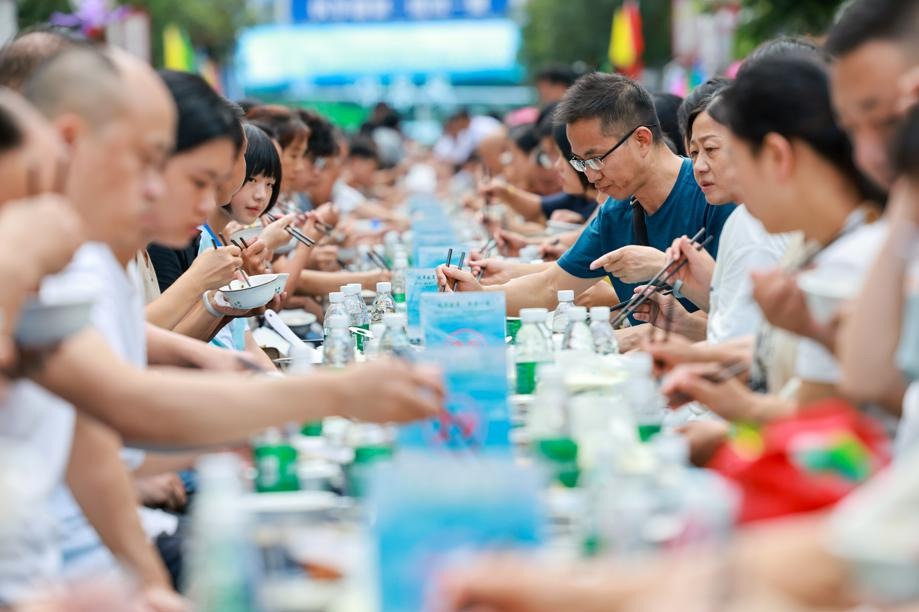Betrayals, big data lead to recovery of treasures

The Ministry of Public Security's Criminal Investigation Bureau disclosed new details surrounding the 2024 breakthrough in the Wuwangdun tomb robbery case on Sunday, unpacking a six-year investigation filled with gang betrayals and cutting-edge forensic technology — its twists and turns rivaling a suspense thriller.
In June 2024, Huainan police in Anhui province successfully cracked the high-profile case involving the robbery of the Wuwangdun tomb. After six years of investigation, police arrested 49 suspects and recovered 113 priceless artifacts last year, shedding light on the secrets hidden within the more than 2,000-year-old tomb.
The Wuwangdun tomb, located in Huainan, is the largest in scale, highest in rank and most structurally complex Chu state tomb ever excavated through scientific measures to date, as recognized by the National Cultural Heritage Administration. It is identified as the final resting place of King Kaolie of Chu, who reigned during the late Warring States Period (475-221 BC).
According to a statement released by the ministry on Sunday, between 2015 and 2018, tomb raiding gangs repeatedly infiltrated the site, causing significant cultural heritage loss. The case came to light in June 2018 when Huainan police received a tip from the Ministry of Public Security and swiftly formed a special task force. Through advanced big data analytics, investigators traced key suspects to Henan province, exposing a sprawling criminal network extending across several provinces.
The gang operated under the guise of "earthwork engineering "companies, employing specialized vehicles and walkie-talkies to evade detection. After multiple thefts from Wuwangdun, they planned to blast open the tomb of Lian Po, a famous general during the Warring States Period.
In a major operation on Nov 5,2018, over 200 police officers simultaneously raided locations across several provinces, capturing 19 suspects and confiscating explosives, detonators and specialized tools to raid tombs.
Investigators prioritized tracking the illicit flow of stolen artifacts, uncovering internal disputes among gang members. Notably, a suspect surnamed Zhang took advantage of a moment when his accomplices were not paying attention to secretly hide a valuable bronze "tiger-seat phoenix-emitting drum" in his hometown in Henan. Police eventually recovered the artifact.
Another suspect, surnamed Sun, secretly made off with a pair of gilded bronze rings behind his accomplices' backs. The rings were retrieved after a three-month cross-border investigation involving the Ministry of Public Security and customs in Shenzhen, Guangdong province.
The exposure of the robbery prompted the National Cultural Heritage Administration to authorize urgent archaeological excavation of the Wuwangdun site, initiated in 2020. In 2024, newly uncovered robbery sketches and abandoned modern tools found at the dig site provided critical leads that reinvigorated the case.
Police re-interrogated key suspects using advanced forensic accounting and digital evidence analysis, leading to 14 more arrests in Shaanxi and Henan provinces and the recovery of an additional 35 artifacts, including fragmented sets of Chu bronze bells and stone chimes that were later painstakingly restored to their original form.
Ultimately, authorities arrested 49 suspects and recovered 113 precious artifacts — including 28 classified as top-tier national treasures.
The excavation of the Wuwangdun tomb received significant recognition in 2024, named among the "top new archaeological discoveries" by the Chinese Academy of Social Sciences and selected as one of the "top 10 national archaeological finds" by the National Cultural Heritage Administration.
- Organic agriculture forum unites global experts in Datong
- Guangdong and Macao launch cross-border medical transfer services
- African, Asian govt officials learn from Shenzhen's economic success
- Mainland slams Lai Ching-te for being US arms dealer's ATM by increasing defense budget
- Arab nations strengthen cultural ties with Ningxia
- China transport sector posts steady seven-month growth





































